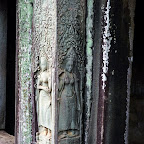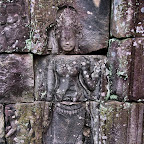Bayon Devata Goddesses of King Jayavarman VII
By Kent Davis
Siem Reap, Cambodia – After Angkor Wat’s unforgettable profile, the face towers of the Bayon temple are the Khmer civilization’s most recognizable architectural icons. In the late 12th and early 13th century King Jayavarman VII built the Bayon as his state temple in the center of his capital city of Angkor Thom. Over the years, the Bayon was modified to accommodate both Hindu and Buddhist rites, according to changing religious preferences. Bayon Devata Goddesses of King Jayavarman VII

On the towers above, serene faces gaze out over the jungle. But below, Jayavarman VII followed the example of King Suryavarman II by filling his monument with female energy. The portraits of sacred women, now called devata or apsaras depending on their style, surround the Bayon. No one knows exactly what the ancient Khmers called these women who are represented so prominently in their temples.

The Bayon primarily features two types of sacred Khmer women: celestial goddesses dancing on lotus flowers, generally located on pillars; and devata, who stand gracefully in niches surrounding the structure.

Dr. Peter Sharrock, School of Oriental and African Studies, has done considerable research on the Bayon, Jayavarman VII’s reign and Khmer religious practices. Sharrock distinguishes the standing devata with the term “courtly devata” because of their elaborate hair and jewelry, as well as their non-dancing stance.
In addition to the courtly devata, Sharrock estimates that the original Bayon structure displayed 6,250 of the celestial dancers; an incredible manifestation of female energy that Jayavarman VII also included in temples such as Preah Khan, Banteay Kdei and Ta Som.
To read more of Sharrock’s work, please see his chapter “The mystery of the face towers,” in Bayon New Perspectives, a compendium of the latest research on this temple.
A second expert, Robert McCarthy, is now cataloging the 377 courtly devata at the Bayon while consulting with the JAPAN-APSARA Safeguarding Angkor project.
For comparison with Angkor Wat, Devata.org has cataloged 1,780 standing devata. The dancing goddesses remain uncounted (but we estimate fewer than Dr. Sharrock has calculated at the Bayon).
Stylistically, the Bayon and Angkor Wat styles have many similarities and differences that will be dealt with in future articles. For convenience, a chart and a few photo examples follow so readers can make immediate comparisons.
Links to detailed photo galleries follow. Bayon Devata Goddesses of King Jayavarman VII
Bayon Devata | Angkor Wat Devata |
Individual devata portraits only | Devata in groups |
“Flame” style crowns common | Triple crown common |
Flower garlands common | None |
Mudras (sacred hand positions) common | Mudras (sacred hand positions) common |
Crossed “sautoir” chest bands common | Rare (only on most powerful devata) |
Higher Waist-Hip Ratio | Lower Waist-Hip Ratio |
Sampot “tail” not seen | Sampot “tail” common |
Lotus pedestal seen | Lotus pedestal extremely rare |
Bayon and Angkor Wat Devata


Bayon Dancing Goddess Trio

Bayon Dancer Pair

Angkor Wat Dancing Apsara

Bayon Photo Gallery of Courtly Devata









































